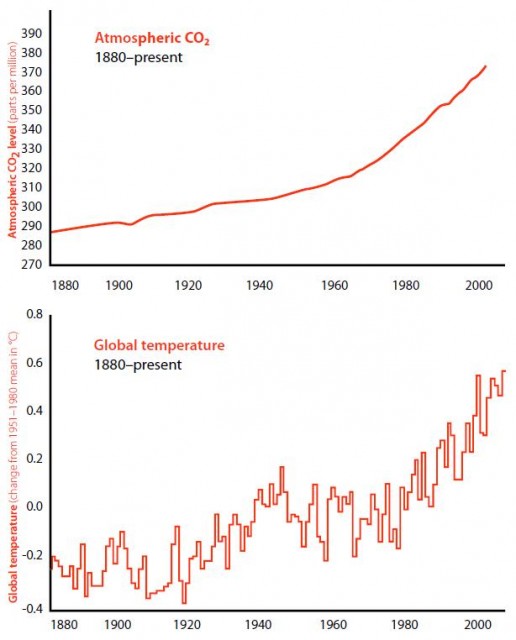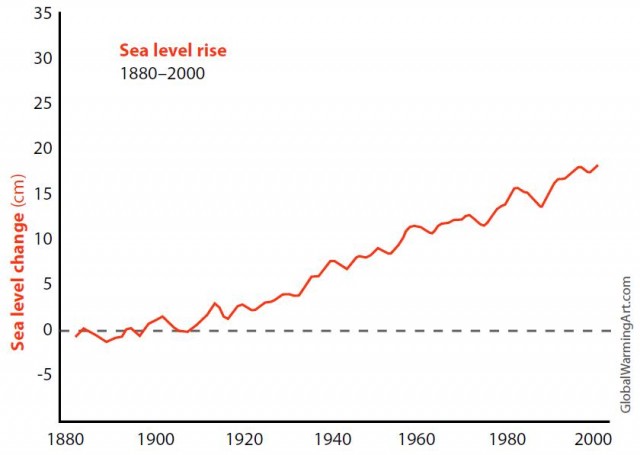Climate change
Oil, coal and gas may be set to run out in the next century or so, but should we be using them in the first place? People have always known that fossil fuels present problems. Oil causes environmental damage when it leaks from pipelines or ships. Burning it produces a wide range of pollutants.
The same goes for coal. In the 1960s, the Central Electricity Generating Board in England decided to avoid complaints about pollution from big coal-burning power stations by building the highest chimneys it could manage to send sulphur dioxide and other combustion products a long way away. The result was an ecological crisis in Scandinavia, with rivers and lakes poisoned by acid rain. And because most oil reserves are in the Middle East, political problems beyond the scope of this book are bound to follow if whole Western societies depend on it. In recent years, these long-familiar problems have been overtaken in popular, political and scientific discourse by the issue of climate change.
The Swedish chemist Svante August Arrhenius (1859-1927) suggested about a hundred years ago that all the coal being burnt might make the Earth warmer by upping the amount of carbon dioxide in the atmosphere. Since then, our knowledge has moved on, but his insight remains valid.
The greenhouse effect
Arrhenius was talking about the greenhouse effect. The term is thrown about a lot despite some doubts that the effect is responsible for keeping actual greenhouses warm.
The greenhouse effect works because most of the Suns energy that arrives at the Earth is in the form of visible and infrared light. That is because the Sun is brightest in that part of the spectrum, as we have seen, which is why it looks yellow. With some exceptions, such as the potentially harmful ultraviolet light that is filtered out by the ozone layer, it passes through the atmosphere and reaches the surface. But the Earth is far cooler than the Sun. So when it emits that energy again, it puts it out at longer wavelengths, deeper into the infrared. (Any physics textbook will tell you more: look under the Stefan-Boltzmann law.) But it happens that molecules of a number of gases naturally present in the atmosphere absorb radiation at these wavelengths, essentially because the chemical bonds between the atoms that make them up resonate at these frequencies. They include water vapour, methane and carbon dioxide. Eventually, the molecules give up the energy they absorb in this way. But when they do so, they emit the radiation that would otherwise have headed into space in any direction at random. So instead of going away, a share of that heat stays behind, and the Earth gets hotter.
We know that the main greenhouse gas in the atmosphere is increasing in abundance. Since 1959, the concentration of carbon dioxide in the atmosphere has been measured at Mauna Loa in Hawaii, a remote spot chosen because it is far away from any local pollution. Between 1959 and 2006 the annual average amount of carbon dioxide in the atmosphere rose pretty consistently from about 315 to about 380 parts per million. Parts per million don't sound like much, but carbon dioxide is a powerful greenhouse gas. The greenhouse effect is real physics, so you cannot have this increase without its having an effect.
While carbon dioxide is the main greenhouse gas, the greenhouse effect is self-feeding. Most of the Earth's surface is water. The hotter things get, the more sea water turns to water vapour, which is a greenhouse gas itself.
Of course, things are not that simple. The non-believers in global warming point out that more water vapour should mean more clouds, which in turn should reflect sunlight away and reduce temperatures.
They add that industrial activity such as coal-burning produces “aerosols” – atmospheric clouds of tiny particles of pollution – that would also reflect energy back into space. Equally, some of the carbon entering the atmosphere may turn into more luxuriant plant life, or more limestone deposits in the oceans.
Maybe the best way to find out whether the Earth is getting warmer is to take its temperature. In the US, the National Climate Data Center has tried to produce average Earth temperatures for the land, the ocean, and the two combined, for the period from 1880 to the present. The figures indicate an average temperature rise of about 1.4°C over that period for the land, and rather less for the oceans. Data gathered through the twentieth century showed that pretty well every-where on Earth got warmer during those hundred years.
Of course, the Earth is part of a more complex system. It has been suggested that the warming that is being observed is to do with the Sun putting out more energy, or with the Earth's orbit allowing it to receive more. However, the majority of scientists now agree that artificial “anthropogenic” emissions of greenhouse gases are the primary cause of global warming.

The results of global warming
Global warming is about climate and weather. Both of these are complex systems that are best discussed statistically, not in terms of specific events. You cannot point out of the window at a hot day and claim that it is due to global warming. Equally, even in a warming world there will still be unexpectedly cold winters – and summers. This applies especially to extreme weather. A single severe storm cannot prove global warming is happening. However, when New Orleans was devastated by Hurricane Katrina in 2005, many experts agreed that this was a rare example of a storm that would probably not have happened, at least on the scale it did, before the era of global warming.
Thinking about what a warmer world would look like has become a major intellectual industry. Most of the prognostications turn out to be unhappy ones.
As we saw in the previous chapter, there would likely be significant sea level rise as major ice masses melted in Greenland and the Antarctic, as well as more regional change such as altered flows in the worlds major rivers caused by melting glaciers. Another unavoidable big effect would be increased erosion and storm damage on ocean shorelines, including ports and cities as well as beaches. Less certain, but looking very possible, would be a large increase in violent storms. There have always been storms, and some enemies of the idea of global warming claim there are no more now than there ever were. However, research published in 2005 suggested that although there were about as many hurricanes as before, the number of them that were very severe was rising. The scientist in charge, Peter Webster, said that rising sea temperatures might well be responsible. It there are to be more violent storms, the southern US and Caribbean will be most affected.
But they would push further north in the US and also become more common in other storm-prone countries such as Indonesia and Australia. The Earths zones of vegetation cannot just move further away from the Equator as warming occurs: deserts would spread and farming would be disrupted. And because a warmer world is also wetter, many parts of the world would have cloudier summers. So global warming might wreck the skiing, but not compensate by providing several months a year of beach parties. In addition, a 2006 study for the UK government showed that human diseases now present in Africa, such as malaria, and animal ones such as Bluetongue, a devastating cattle disease, might spread north into Europe, with direct effects on human health and well-being.
The real problem with global warming is that it is not happening in a wild world whose natural systems will sort things out. When Europe warmed up in the Middle Ages, the effects were limited because most
of the affected area was wild. When the climate changes now, things are very different. The obvious case is sea level rise. Sea levels around the world rose by 10-25cm during the twentieth century. When the sea rises, the coast does not just move back. Instead, it arrives at houses, ports and concrete sea defences. The narrow strip of beach, mangrove or some other wild land is the first to be destroyed.

As we have seen, the root cause of global warming is the fact that carbon built up inside the Earth over millions of years is being released in just a few decades. It is not surprising that this has environmental effects. But it also means that doing something about it is tricky. A raft of steps have been proposed to cut fossil-fuel use, or to reabsorb the carbon they release. The measures suggested range from expanding nuclear power to planting more trees. But it is not likely that carbon dioxide concentrations will start to come down before the middle of the century. That means that temperatures will probably go on rising at least until then.
The immense effects of global warming described above would far exceed all the previous environmental damage done by humans. They are also genuinely global, while most environmental problems are local or national in scale. So lets think of global warming as a huge issue in its own right – but also as a cue to reorganize the whole way we deal with the world around us.